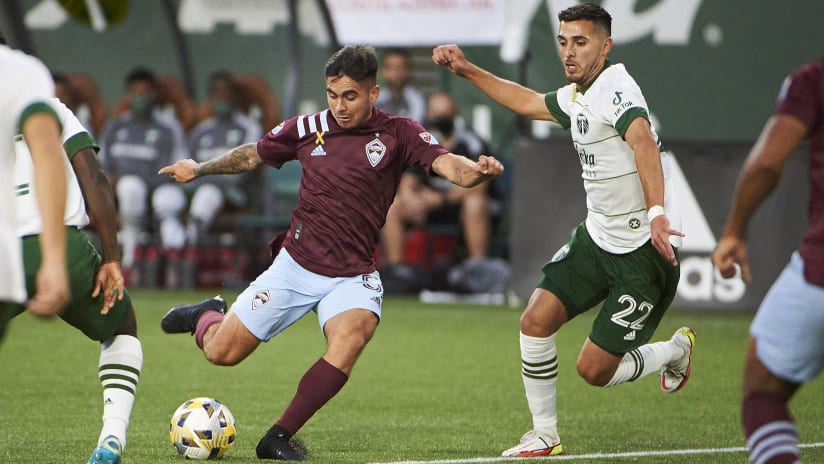Scientifically speaking, there are few better ways to fight off a tryptophan-induced nap than with a Western Conference Semifinal in the Audi 2021 MLS Cup Playoffs.
Okay, that’s not really true. Tryptophan isn’t some sort of instant sleep potion, so you can go ahead and load up on that turkey, and somehow scientists haven’t gotten around to testing whether soccer can help a test subject fight off an oncoming nap.
But the point is, we’ve got MLS on Thanksgiving this year!
On Turkey Day, the West's top-seeded Colorado Rapids will take on the Fighting Sebastian Blancos ... erm, I mean the four-seeded Portland Timbers, who topped Minnesota United 3-1 in Round One.
What can we expect to see from these two teams, between bites of green bean casserole of course, as they fight for a spot in the Western Conference Final?
Here's a breakdown of what awaits Thursday at Dick's Sporting Goods Park (4:30 pm ET | FOX, FOX Deportes)
By the time Thursday rolls around, it will have been 18 days since the Rapids pulled off their Decision Day heist that sent them atop the Western Conference table.
The Rapids don’t have a traditional star player – lone Designated Player Younes Namli had ankle surgery in June and has contributed 1g/1a in 532 minutes this year – but they certainly have a team-wide approach. According to Second Spectrum, Colorado compiled the second-most expected goals in the regular season on counter-attacks. With quick, straight-line players in the frontline, the Rapids’ personnel fits the counter-attacking mold.
"We're in control of the game with the ball when we have possession, but also the biggest thing is without the ball," Rapids captain Jack Price told Burgundy Wave earlier this month (emphasis mine).
That focus on defensive solidity while playing without the ball has served Colorado well (they allowed the seventh lowest xG total in MLS in 2021) and it’s served as a foundation for their aggressive transition attacks.
But the Rapids don’t just attack on the break. They also use the field to possess and take advantage of dead-ball situations.
In possession, the Rapids use the width of the field to spread the opposition defense and create gaps. They averaged the fifth widest possessions in MLS, only behind four true possession teams (Austin FC, the LA Galaxy, Sporting Kansas City and Atlanta United) and they’re in the top 10 in passes per possession and average possession duration.
Despite spending an above-average amount of time in traditional possession phases, head coach Robin Fraser’s team is below-average at creating goalscoring chances from possession. The Rapids are 20th in MLS in xG created from buildup, maintenance, progression and attacking phases.
Still, Colorado’s defined possession shape and structure gives them another look that can be useful in the postseason – and could help them carve through a struggling Portland defense.
When the ball is stopped, the Rapids are one of the best set piece teams in MLS. They averaged the fourth highest xG per corner kick/free kick in the regular season and scored 13 goals from those restarts. Only New York City FC scored as many goals on corners and free kicks as the Rapids did this year.
The Rapids aren't a traditional No. 1 seed, but they certainly have the tools to carry their regular-season momentum into a playoff run – and possibly to MLS Cup on Dec. 11.
When you look at the data, few teams left standing in the playoffs have defined, set-in-stone strengths and weaknesses like Portland.
With the ball, the Timbers are one of the most dangerous teams in MLS; only five teams compiled more xG from open play than Portland in the regular season. That number is pretty impressive on its own, but when you zoom in to the last two months of the regular season, it starts to look even better. Between Aug. 1 and the start of the playoffs, Portland amassed the most goals in the league and the third most xG per game in the league just behind LAFC and their Thanksgiving foes.
A major reason behind that offensive output is a 5-foot-7 Argentine attacking midfielder.
I didn’t just choose Aug. 1 as a random date above. No, that was when Sebastian Blanco started playing more consistently for the Timbers after rehabbing from a knee injury. With Blanco in the lineup, Portland became increasingly hard to stop. Just ask Minnesota how hard it is to keep tabs on the diminutive Argentine.
And if you don’t trust Loons fans to give you a straight answer, well, you can just look at the numbers. In the last two months of the regular season, Blanco posted the fourth most xA in MLS, the most xG of any out-and-out attacking midfielder, and the fifth most goals added (courtesy of American Soccer Analysis) of any regular player.
Blanco is a real, genuine threat to take down any team in the league, even a solid defensive team like the Rapids. Add in Felipe Mora, whose movement between the penalty spot and the goal line makes him one of the most dangerous No. 9s in MLS, and you’ve got yourself a good, old-fashioned 9/10 combination.
For all the good things Blanco and Co. have cooking in the attack, there are real concerns about the Timbers’ defensive chops. Only three teams gave up more open-play xG in the regular season and no other team allowed more xG on free kicks and corner kicks than Portland.
Those open-play defensive issues popped up early in Portland's Round One playoff game against the Loons. Minnesota strung together a 12-pass sequence that bypassed Blanco and Mora up top, split Diego Chara and Cristhian Paredes in central midfield, and ended with a Franco Fragapane tap-in at the back post.
As the game progressed, Portland shored things up defensively (and Minnesota stopped attacking so aggressively), but nonetheless: Portland will need to be smarter about how they play without the ball on Thursday if they want to stop Colorado, who can hit them in a bunch of different ways.
With Blanco’s heroics, a potential battle on set pieces, the Rapids’ varied attacking threats and my unnecessarily large plate of mashed potatoes, there’s plenty to watch during Colorado and Portland’s Thanksgiving tussle.













